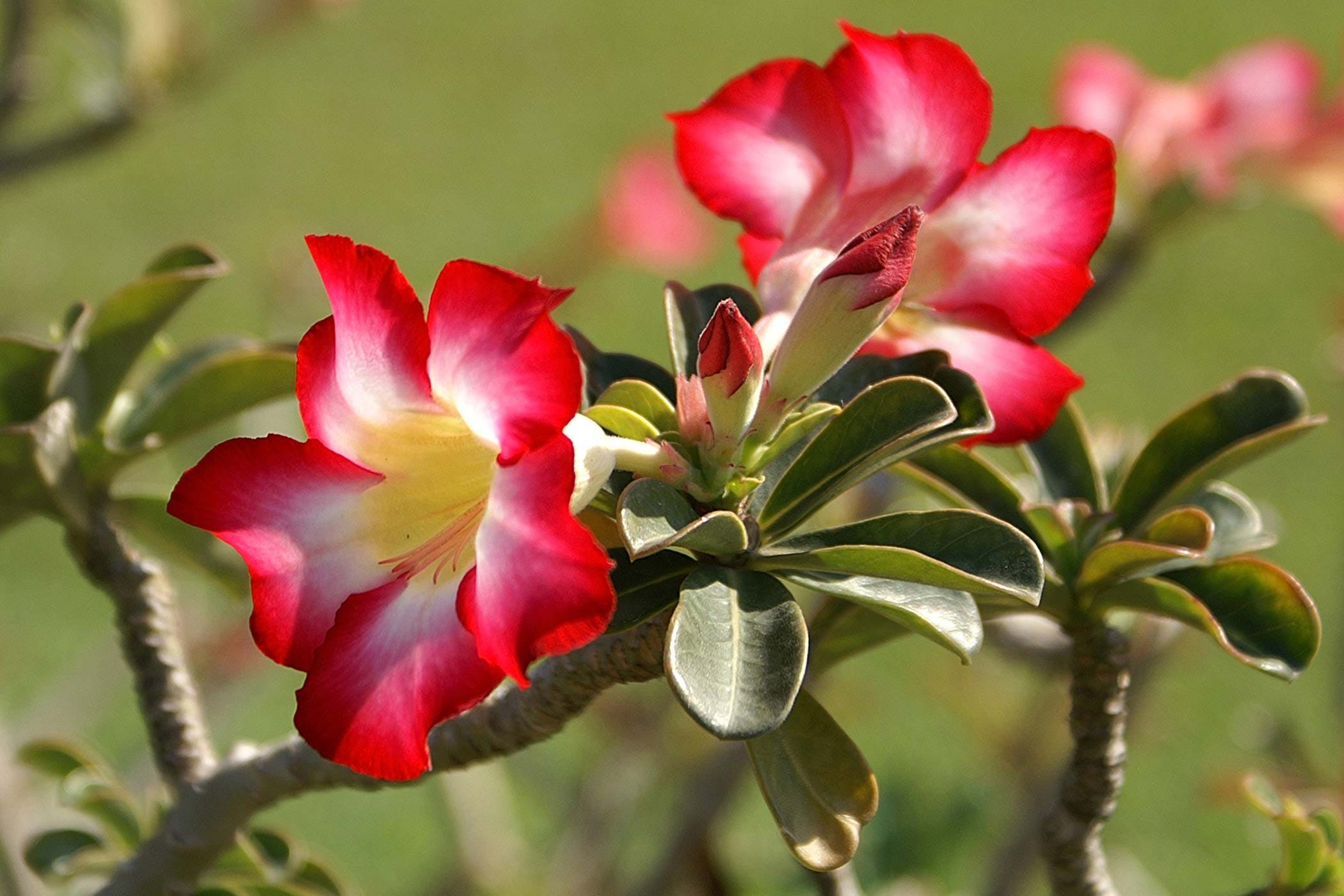
Welcome to the enchanting world of the Desert Rose, scientifically known as Adenium obesum. This remarkable succulent, native to arid landscapes of East and Northeast Africa as well as the Arabian Peninsula, has captivated hearts with its striking appearance and resilient nature. From its historical uses in traditional medicine to its adaptation to diverse climates worldwide, the Desert Rose has become more than a plant—it’s a symbol of beauty, endurance, and cultural significance. Join us on a journey as we explore the fascinating facets of this iconic succulent, from its geographical origins to its economic importance, unveiling the stories embedded in its bulbous trunk, vibrant flowers, and the delicate dance of survival it performs in challenging environments.
Geographical Origin: Adenium obesum, commonly known as the Desert Rose, originates from the arid regions of East and Northeast Africa as well as the Arabian Peninsula. Flourishing in conditions of limited water availability, this succulent has adapted to survive in the challenging environments of deserts and semi-arid landscapes. Its ability to thrive in such harsh conditions makes it a resilient and iconic plant in these regions.
Historical Uses in Traditional Medicine: The Desert Rose has a historical connection to traditional medicine in its native areas. Various parts of the plant are believed to possess medicinal properties, and in some cultures, it has been used to treat ailments. While its medicinal applications are deeply rooted in local traditions, the plant’s use in modern medicine is limited, and caution is advised due to its toxicity.
Appearance and Growth: Adenium obesum is recognized for its striking appearance. Its bulbous trunk, vibrant pink or red flowers, and leathery leaves contribute to its unique charm. Given favorable conditions, the Desert Rose can reach heights between 6 to 10 feet, making it a visually captivating addition to gardens and landscapes.
Cultural Symbolism: Beyond its physical attributes, the Desert Rose carries cultural symbolism. In various societies, it is often associated with beauty and resilience. Its ability to thrive in arid conditions has led to its symbolism as a representation of endurance and tenacity, making it a popular choice in cultural and artistic contexts.
Cultivation Outside Native Regions: The adaptability of the Desert Rose has led to its cultivation as an ornamental plant in diverse climates worldwide. Gardeners in arid and semi-arid regions, as well as those practicing container gardening, appreciate the plant’s ability to thrive with minimal water. Its popularity as a decorative plant has contributed to its spread beyond its native habitats.
Drought Tolerance: A standout characteristic of the Desert Rose is its exceptional drought tolerance. Evolving in arid landscapes, the plant has developed mechanisms to conserve water and endure extended periods of dryness. This adaptation makes it a valuable addition to gardens in regions with water scarcity.
First Descriptions: The first detailed descriptions of Adenium obesum were provided by the French botanist Michel Adanson in 1763. Adanson’s observations and documentation laid the foundation for the plant’s formal recognition in botanical records.
Taxonomy: Adenium obesum belongs to the Apocynaceae family and is part of the larger genus Adenium. Its classification within the botanical taxonomy provides insights into its evolutionary relationships and botanical characteristics.
Common Names: The Desert Rose is known by various names, reflecting its widespread cultivation and recognition across different cultures. In addition to its scientific name, it is often referred to as Sabi Star, Kudu, and Mock Azalea, among other regional names.
Varieties and Hybrids: Over time, horticulturists have cultivated various varieties and hybrids of Adenium obesum, resulting in a diverse range of flower colors and forms. These cultivated variations showcase the plant’s adaptability to selective breeding, allowing for a plethora of choices for enthusiasts and gardeners.
Popular Bonsai Species: Adenium obesum, the Desert Rose, has gained popularity as a bonsai species due to its distinctive trunk formation and its ability to adapt to pruning. Bonsai enthusiasts appreciate its unique aesthetic, with the bulbous base of the trunk resembling a miniature tree in nature. The Desert Rose’s adaptability to bonsai cultivation has made it a sought-after choice for those practicing the art of miniature tree cultivation.
Toxicity: Parts of the Desert Rose plant, particularly its sap, are toxic if ingested. It contains compounds such as cardiac glycosides that can be harmful to humans and animals. This toxicity highlights the importance of handling the plant with care and ensuring that it is kept out of reach of children and pets.
Conservation Status: In some regions, the Desert Rose faces conservation challenges due to habitat loss and over-harvesting, particularly for the horticultural trade. Conservationists and botanists are working to address these issues and implement measures to protect natural populations and promote sustainable practices in the cultivation of this species.
Dormancy Periods: The Desert Rose experiences dormancy periods, particularly during the dry season in its native environment. During this time, the plant sheds its leaves as a survival strategy to conserve water and energy until more favorable conditions return. Understanding these natural cycles is crucial for successful cultivation.
Propagation Methods: Desert Rose can be propagated through various methods, including seeds, cuttings, and grafting. Each propagation method has its advantages and challenges, and successful propagation often requires a combination of proper techniques and environmental conditions.
Floral Characteristics: The flowers of the Desert Rose are a defining feature, typically tubular and showy, with a diameter ranging from 2 to 3 inches. The vibrant hues, including shades of pink and red, contribute to its ornamental value and visual appeal, attracting pollinators in its natural habitat.
Timeline of Horticultural Interest: The Desert Rose gained significant horticultural interest during the 20th century, spreading its cultivation beyond its native regions. This increased attention led to the introduction of various cultivars and hybrids, expanding the range of options available to gardeners and collectors.
Adaptation to Container Gardening: One of the remarkable features of the Desert Rose is its adaptability to container gardening. Its ability to thrive in pots and containers makes it a popular choice for indoor or patio gardens, allowing individuals in various climates to enjoy its beauty and unique form.
Influence on Art and Design: The unique appearance of the Desert Rose has inspired artists and designers in various fields. Its distinctive trunk, beautiful flowers, and overall structure have influenced landscape designs, botanical art, and even architectural elements in regions where it is cultivated.
Propagation Challenges: While seeds are the most common method of propagation for the Desert Rose, growing it from seeds can present challenges. Successful germination often requires specific conditions, including well-draining soil, proper temperature, and patience, making it an interesting yet sometimes challenging plant to propagate.
CITES Listings: Certain varieties of Adenium obesum are listed under the Convention on International Trade in Endangered Species of Wild Fauna and Flora (CITES). This international agreement aims to regulate and monitor the trade of species to ensure that it does not threaten their survival in the wild. The inclusion of some Desert Rose varieties in CITES listings underscores concerns about over-harvesting and the need for sustainable practices in the plant’s trade.
Temperature Sensitivity: The Desert Rose is sensitive to cold temperatures, and exposure to frost can result in damage or dieback of the plant. This temperature sensitivity reinforces the importance of providing protection during colder months, especially in regions where frost is a common occurrence.
Timeline of Hybrid Development: Horticulturists and enthusiasts have actively engaged in the development of numerous hybrids of Adenium obesum. This timeline of hybrid development has led to a diverse array of cultivars, each showcasing variations in flower color, size, and overall plant structure. The continuous exploration and creation of hybrids contribute to the richness of the Desert Rose’s horticultural landscape.
Commercial Trade: The Desert Rose holds economic significance in the international horticultural trade. Its popularity as an ornamental plant has driven a thriving market, with enthusiasts, collectors, and gardeners seeking out various cultivars and hybrids. The commercial trade also emphasizes the need for responsible and sustainable practices to ensure the continued availability of the plant.
Longevity: When provided with proper care, Desert Rose plants can exhibit remarkable longevity, with some individuals living for several decades. This characteristic adds to the allure of cultivating Adenium obesum, as gardeners and enthusiasts can establish long-term relationships with these unique plants, witnessing their growth, flowering cycles, and adaptation over the years. Understanding the factors that contribute to their longevity is essential for fostering healthy and enduring Desert Rose specimens.









